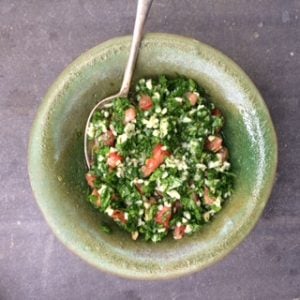
It is time for me to start thinking about sowing winter herbs for the glasshouse. Parsley has slowly crept into my life in a big way. It used to be a herb I shunned – a white parsley sauce has a sort of bland, milky, mildly green flavour that I have never got on with. But few of us have escaped gradual Ottolenghification in the kitchen, and Ottolenghi has been almost entirely responsible for a rehabilitation of parsley in mine. Now I generally use it differently, alongside strong flavours, to lend its bright green and grassy notes to richer dishes than a pale sauce. I do use it in great handfuls though, chopped and stirred into braised lentils just before serving, or into a rich tomato sauce, or sprinkled over baked chicken thighs just out of the oven. The flecks of green bring everything else to life, and the flavour is never strong enough to overwhelm, just to layer and enhance.
I use so much of it that I try to always have some growing, and as the greenhouse is currently almost empty this is the time to get some started for winter crops. Coriander and chervil can likewise be started now too, and both will produce leaves through winter, sown now and given a little under-glass protection when the weather turns cold. Sow all into modules of peat-free compost, then water well. Parsley germination is slow and patchy, so sow lots and be patient. Coriander and chervil should germinate more readily. Once all are up thin them out to give each plant plenty of space, and plant them up into individual pots fairly soon after this. Parsley grows slowly but it doesn’t like to be crowded out. You can plant into the ground if you have cloches with which to cover your plants through winter (cold won’t generally kill any of these herbs, but you will have a much lovelier quality of leaf if you give it a bit of protection).
While I most often use it as a generous garnish, parsley is brilliant when used almost like a salad leaf, in tabbouleh. Tabbouleh in the UK is generally a bulgur wheat salad flecked with parsley, but in its native incarnation it is far more of a parsley salad flecked with bulgur. And so you will need great handfuls of parsley, and a little mint, at least in summer when there is plenty of it around. Tabbouleh traditionally contains ripe diced tomatoes, but I make a winter version too with finely chopped cauliflower and radish instead, as tomatoes in winter are so awful. Here is the summer version, for the parsley that is growing well now, but hold the other version in mind for when the seeds you are just sowing in the greenhouse now produce a crop in the depths of winter.
Tabbouleh (summer version)
25g bulgur wheat
Large bunch flat leaf parsley
Two sprigs mint
2 ripe tomatoes, diced
2 spring onions, finely sliced
Juice of one lemon
3 tablespoons extra virgin olive oil
Salt and pepper
Wash the bulgur wheat and then tip it into a saucepan with 100ml water and bring to the boil. Reduce to a simmer for 10 minutes or until most of the moisture is absorbed but the wheat still has some bite. Fluff up with a fork and leave to cool. Wash and finely chop the parsley and mint leaves, then combine with the chopped tomatoes and spring onions. Add the lemon juice and oil and a little salt and pepper to taste. Leave the flavours to meld for half an hour or so, or serve immediately.


